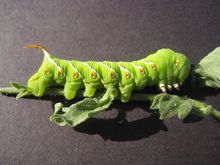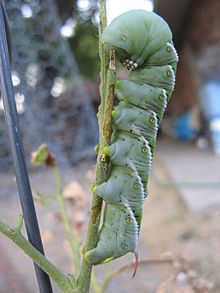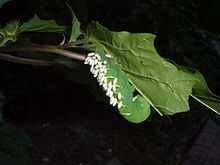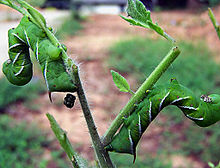- Manduca sexta
-
Manduca sexta 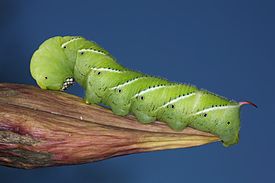
Scientific classification Kingdom: Animalia Phylum: Arthropoda Class: Insecta Order: Lepidoptera Family: Sphingidae Genus: Manduca Species: M. sexta Binomial name Manduca sexta
(Linnaeus, 1763)[1]Synonyms - Sphinx sexta Linnaeus, 1763
- Protoparce sexta
- Phlegethontius sexta
- Sphinx carolina Linnaeus, 1764
- Manduca carolina
- Phlegethontius carolina
- Protoparce carolina
- Macrosila carolina
- Protoparce jamaicensis Butler, 1876
- Sphinx lycopersici Boisduval, [1875]
- Sphinx nicotianae Boisduval, [1875]
- Sphinx paphus Cramer, 1779
- Protoparce griseata Butler, 1875
- Protoparce leucoptera Rothschild and Jordan, 1903
- Protoparce sexta luciae Gehlen, 1928
- Protoparce sexta peruviana Bryk, 1953
- Sphinx caestri Blanchard, 1854
- Sphinx eurylochus Philippi, 1860
- Sphinx tabaci Boisduval, [1875]
- Protoparce sexta saliensis Kernbach, 1964
Manduca sexta is a moth of the family Sphingidae present through much of the American continent. Commonly known as the tobacco hornworm, it is closely related to and often confused with the very similar tomato hornworm (Manduca quinquemaculata); the larvae of both feed on the foliage of various plants from the family Solanaceae. The tobacco hornworm can be distinguished by its seven diagonal lines on its sides; tomato hornworms have eight V-shaped markings.[2] A mnemonic to remember the markings is tobacco hornworms have straight white lines like cigarettes, while tomato hornworms have V-shaped markings (as in "vine-ripened" tomatoes). M. sexta has mechanisms for selectively sequestering and secreting the neurotoxin nicotine present in tobacco.
M. sexta is a common model organism, especially in neurobiology, due to its easily accessible nervous system and short life cycle. It is used in a variety of biomedical and biological scientific experiments. It can be easily raised on a wheat-germ based diet. The larva is large and thus relatively easy to dissect and isolate organs.
Contents
Subspecies
- Manduca sexta sexta (from Massachusetts west across southern Michigan to Minnesota, central Colorado, and northern California, south to Florida, the Gulf Coast, Texas, New Mexico, Arizona, and southern California and then further south through Mexico, Belize, Honduras, Nicaragua, Costa Rica, and the West Indies to Argentina)
- Manduca sexta caestri (Blanchard, 1854) (Chile)
- Manduca sexta jamaicensis (Butler, 1875) (Jamaica, the Dominican Republic, St. Lucia, Guadeloupe and throughout the Antilles)
- Manduca sexta leucoptera (Rothschild & Jordan, 1903) (Galapagos Islands)
- Manduca sexta paphus (Cramer, 1779) (Surinam and Venezuela to Brazil, Argentina and Bolivia)
- Manduca sexta saliensis (Kernbach, 1964) (Argentina)
Life cycle
M. sexta have a short life cycle, lasting about 30 to 50 days. In most areas, M. sexta have about two generations per year, but they can have about three or four generations per year in Florida.[3]
Eggs
M. sexta eggs are spherical, approximately 1 millimeter in diameter, and translucent green in color. They typically hatch 2–4 days after they are laid. Eggs are normally found on the underside of foliage, but can also be found on the upper surface.
Larvae
M. sexta larvae are green in color and grow up to 70 millimeters in length. Under laboratory conditions, while fed a wheat-germ based diet, larvae are turquoise due to a lack of pigments in their diet. M. sexta blood contains the blue-colored protein insecticyanin. When the larva feeds on plants it ingests pigmentacious carotenoid proteins. Carotenoids are primarily yellow in hue. When bound together, the protein complex is green.
During the larval stage, M. sexta caterpillars feed on plants of the family Solanaceae, principally tobacco, tomatoes and members of the Datura genus. Near the end of this stage, the caterpillar seeks a location for pupation, burrows underground, and pupates. The searching behaviour is known as "wandering." The instinct of wandering can be visually confirmed by spotting the heart (aorta) which is a long, pulsating vein running along the length of the caterpillar's dorsal side. The heart appears just as the caterpillar is reaching the end of the final instar. M. sexta has five larval instars which are separated by ecdysis (molting), but may add larval instars when nutrient conditions are poor.
A common biological control for hornworms is the parasitic braconid wasp, Cotesia, which lays its eggs in the bodies of tobacco hornworms. The wasp larvae feed internally, and emerge from the body to spin their cocoons. Parasitized tobacco hornworms are often seen covered with multiple white, cottony wasp cocoons, which are often mistaken for large eggs.
Pre-pupae
Before the larva pupates, it goes through a stage called the pre-pupa, where its shrinks considerably and prepares to pupate. Often, people mistake this stage as a dead, or dying, caterpillar.
Pupae
The pupal stage lasts approximately 18 days under laboratory conditions (17 hours light, 7 hours dark, 27°C). When reared on a short-day photoperiod (12 hours light, 12 hours dark), pupae enter a state of diapause that can last several months. During the pupal stage, structures of the adult moth form within the pupal case which is shed during eclosion (adult emergence).
Adults
Adult M. sexta are known as Carolina Sphinx moths. M. sexta moths are nectarivorous and feed on flowers, demonstrating a remarkable ability to hover.
Adult males and females are sexually dimorphic. Males are identifiable by their broader antennae and the presence of claspers at the end of the abdomen. Female moths are typically ready to mate one week after eclosion, and do so only once. Males may mate many times. Mating generally occurs on a vertical surface at night, and can last several hours, with the male and female facing in opposite positions, their posterior ends touching. After mating, females deposit their fertilized eggs on foliage, usually on the underside of leaves.
Laboratory Rearing
Like drosophila melanogaster, Manduca sexta is commonly used as a model organism for experiments. M. sexta are frequently studied in the laboratory due to their large size and relative ease of rearing. They may be reared on host plants, such as tobacco and tobacco relatives, tomato plants, or wheat germ based artificial diet. Their rearing is straightforward, as long as they receive a "long day" (i.e., 14 hour) daylight cycle during development to prevent diapause.
Eggs are rinsed for one to five minutes in diluted household bleach, at Binghamton University .05% Clorox is used.
Eggs are placed on diet cubes or host plants. The eggs hatch and develop at different speeds depending on temperature. The Manduca are moved to fresh diet or leaves as their food spoils or is consumed. When the Manduca "wanders" (non-stop walking) it is about to pupate and is placed in a pupation chamber. Pupation chambers are holes drilled into a wood board. The Manduca larvae is sealed in the chamber using a stopper, and allowed to pupate. After pupation the pupae is placed in a breeding or colony chamber to eclose. Providing a cup of sugar water and a tobacco (or related plant) will allow mated females to oviposit fertile eggs, which can then be reared.
When fed an artificial diet Manduca larvae do not consume the Xanthophyll needed to produce their green coloration, instead they appear blue. On some diets the Manduca have very little pigment and pigment precursors, so the Manduca larvae are a very pale blue-white. As vitamin A and other carotenoids are necessary for the visual pigments (rhodopsin,) it is worth noting that an artificial diet-reared manduca may have poor vision due to lack of carotenoids in the diet.[citation needed]
Hornworm Moth Variety
References
- ^ "CATE Creating a Taxonomic eScience - Sphingidae". Cate-sphingidae.org. http://www.cate-sphingidae.org/taxonomy/Manduca/sexta.html. Retrieved 2011-06-16.
- ^ Villanueva, R. (2007). "Tobacco hornworm, Manduca sexta (Linnaeus). Featured Creatures". http://entomology.ifas.ufl.edu/creatures/field/hornworm.htm. Retrieved July 24, 2008.
- ^ Eichman, Aaron; Weston Tripp, Matt Edwards (2000). "Manduca sexta "Carolina sphinx"". http://bugs.clemson.edu/museum/moths/local/moth1.htm. Retrieved October 21, 2006.
External links
Categories:- Manduca
- Agricultural pest insects
- Tomato pathogens and pests
- Animals described in 1763
Wikimedia Foundation. 2010.

